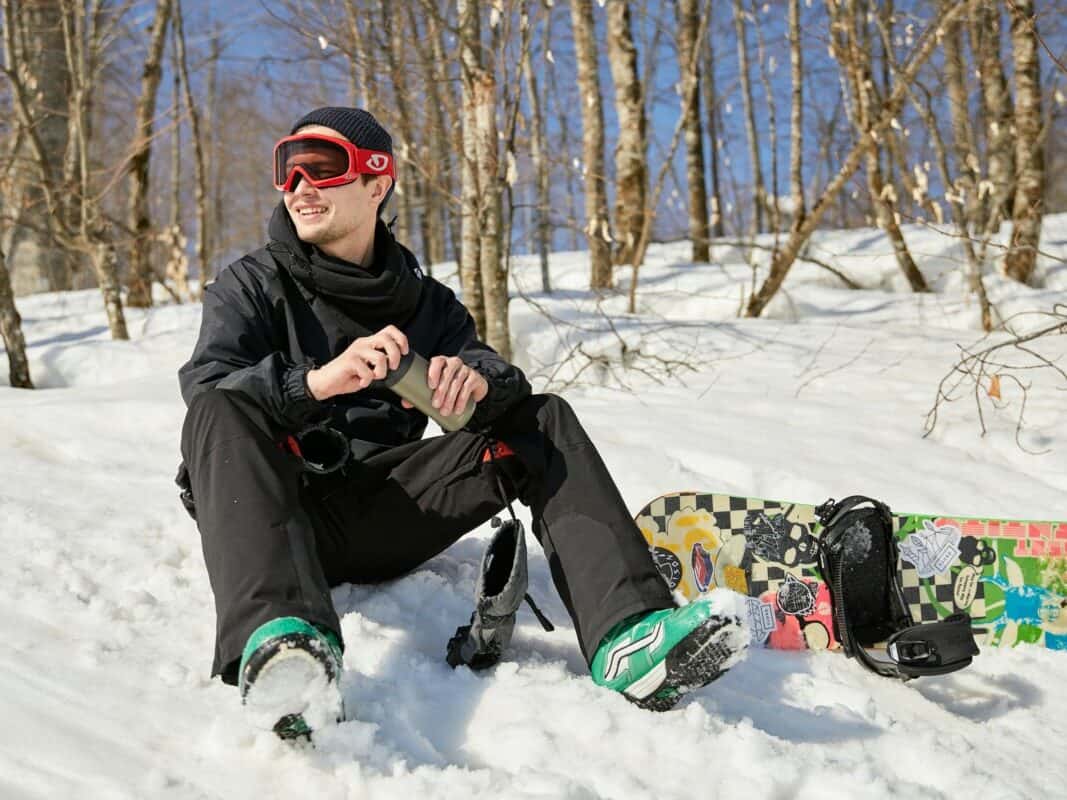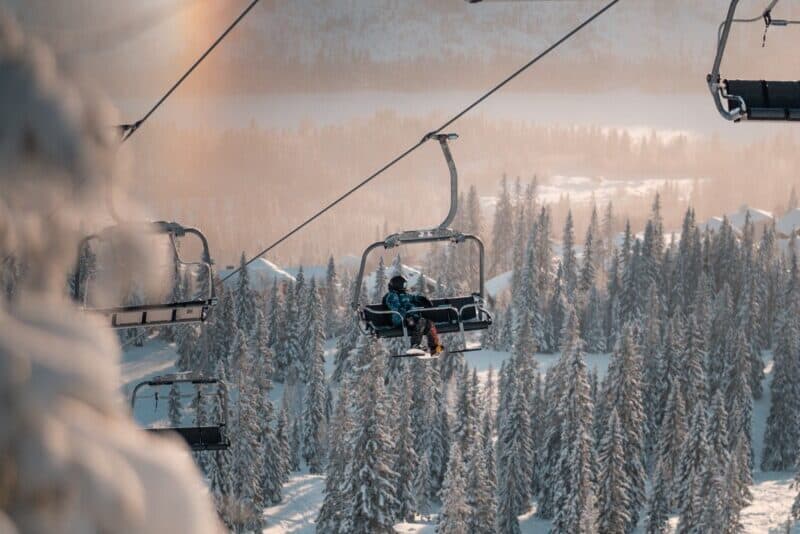
Skiing and snowboarding are physically strenuous high-demand sports. It is important to stay hydrated while at the resort. However, when it comes to skiing and snowboarding, finding the right water bottle or hydration system can be tricky.
The best water container to use while skiing and snowboarding needs to meet four requirements:
It needs to be. . .
- Durable
- Unobtrusive and light weight
- Easily accessible
- Protected from freezing

Dehydration Can Sneak Up on Skiers and Snowboarders
In high altitudes and cold temperatures, sweat evaporates more quickly and respiration retains less water. Meanwhile, the body’s sensation of thirst is repressed1. Needless to say, dehydration can sneak up on skiers and snowboarders at the resort. I’m surprised how often I see skiers and snowboarders neglect to bring water. Maybe they don’t feel they need it. Or, maybe they think that carrying water adds excessive bulk. Maybe both.
I understand the inconvenience of carrying excessive bulk while skiing–like when wearing a jossly backpack. Bombing the fall-line, shredding the gnar, jump-turning the steeps, hitting big-air kickers, jamming through tight tree runs and powering through demanding moguls all require a high level of agility that can be hampered by a jossly pack.
That being said, while skiing or snowboarding, you often don’t realize how dehydrated you are. As mentioned above, colder temperatures reduce the body’s thirst cravings2. Sometimes, it takes a tough boot-pack through deep snow—to get out of a gnarly jam, or a long push-out on a catwalk for you to realize how incredibly thirsty you are. Especially in cold temperatures, is important not to let thirst determine when to drink3. Gradual energy loss and slow muscle recovery between runs are much more subtle symptoms of dehydration that are often overlooked4 and often shorten your stay at the resort.
An expensive trip to the ski resort is short lived if you neglect to bring water and keep yourself properly hydrated. Without hydration, the body gets tired and sluggish, fingers and toes get colder quicker, muscles cramp up, and achy exhaustion sets in. All-day plans to hammer the slopes fizzle to just a handful of good runs before you’re literally aching to go home.
Alternatively, staying hydrated increases physical and mental stamina and also helps the body regulate temperature–both greatly needed while on the slopes. Staying hydrated at the ski resort is a must.
Top 6 Water Bottle Picks for Skiing and Snowboarding
Here are my top six hydration systems for resort skiing and snowboarding. They are durable, unobtrusive, easily accessible and wont freeze:
Please note, I am an Amazon Associate and receive a small affiliate commission when you click and purchase from the links on my site. It helps fund this project. The following items have been carefully chosen and have excellent reviews.
- Go-To Favorite: the 10oz Adalid Gear Runner’s Water Bottles.
I originally bought these affordable water bottles to carry water within my runner’s belt pack. However, I’ve found that the versatility of these little guys has earned them a spot as my go-to when skiing as well. They are made out of soft durable BPA free plastic. They are small rectangular shaped and contour unobtrusively in my front pocket. (I’ll often carry one in each front pocket). They have a push-pull cap that makes them easy to access and drink with just one hand. On cold days when I’m worried about them freezing, I’ll zip them into the front pocket of my underlayer fleece or vest. Easy to fill, easy to clean, easy to access, just the right size (not too big and not too small), and durable. Easy choice—they are my favorite. - Bomber Proof: Wide Mouth 500ml Rectangular Nalgene water bottle.
It is bigger than the Adalid–holding about 16oz of water. Again, the rectangular shape is less obtrusive than a 500ml (16oz) cylindrical water bottle. It’s made out of a soft plastic HDPE material. It’s bomber proof and fits in my front pocket which makes it easily accessible. The only downside to this water bottle is the screw-top lid—just gotta be careful not to drop it while riding the lift.
Seriously, I can’t say enough good things about HDPE Nalgene water bottles. I prefer them over hard Tritan bottles–as the HDPE bottles don’t clunk around as much. They are virtually indestructible. I use them on backcountry tours, hiking, backpacking, and regular everyday use. On days when I plan to only spend a half-day at the resort, I sometimes bring the smaller Nalgene HDPE 250ml Narrow-Mouth Round bottle. - Collapsible: HydraPak Stow (500ml) Collapsible Water Bottle.
Water flasks are made of a soft TPU plastic that molds into the shape of the pocket they are stowed in. One of its top benefits is that it is collapsible. The more you drink, the less space it takes up in your pocket—something that is greatly appreciated as the ski day wears on. Flasks such as the Hydrapak Stow, or a smaller version: HydraPak Softflask 250ml, are more durable than you’d expect. And, since they can be stowed into the front or breast pocket, they aren’t typically going to be a direct point of impact when taking a fall in the snow. - Snuggest Fit: CamelBak Ultra Running Hydration Belt.
If you need your flask to hug your body and be much less jossly than in the pocket, you can put them in a hip pack such as this one. I like this one because it does not have a buckle and just slides on over your underlayer. It comes with a 17oz Quik Stow flask. Though it is designed to carry a phone and fuel in front, I’d turn it around and wear it with flask access pocket in front for easier access. Of course there are other belt pack options out there, however, this one’s minimalistic design and snug fit make it a discreet and comfortable way to carry water—no one will even notice your packing water under your jacket. - Easiest Access to Water: CamelBak Bootlegger.
Some skiers and snowboarders like to wear a hydration pack. The CamelBak Bootlegger is one of the best options for resort skiing. It has an insulated tube, bite-valve and reservoir compartment. It fastens with two sternum straps for a snug fit that minimizes jossle.
My biggest beef with winter hydration packs is that they tend to be more jossly than I’d prefer and the hose and bite valve lend themselves to freezing. However, the CamelBak Bootlegger’s slim minimalistic design is slender enough to wear under the jacket—solving both problems of jostle and freezing. Hydration packs provide the easiest access to water—you can literally hydrate while on the fly. - Most Innovative: 686 Gore-Tex Hydrastash.
This jacket has a built in hydration sleeve and 25oz water bladder that wraps around the powder skirt. It provides easy tube access to water and is so unobtrusive people say they don’t even notice that it is there. I have to admit, I don’t own this expensive jacket. But the concept is genius and probably revolutionary in the industry.
Refill, Replenish, Stay Hydrated
Finding the balance between how big of a water container to bring and how much bulk you prefer to ski with is a personal preference. Hydration packs and larger water bottles allow more water to be carried but also add bulk. I’m one of those skiers who prefers to keep weight and bulk at a minimum. Subsequently, I’ll stop at the lodge a couple of times during the day to refill my water bottles.
I know other skiers who prefer to carry a full hydration pack and the extra bulk so they don’t have to fill up at the lodge. And, their logic is sound: the easier and more convenient it is to access water, the more likely it will be to stay consistently hydrated.
The key is to decide what your preference is and to make sure to stay hydrated.
Prioritizing hydration will not only extend your stay at the ski resort, your days on piste will be so much more safe and enjoyable.
I hope to see you on the slopes. Be safe and stay hydrated!
Sources:
1Dehydration is a risk even during the winter
2Are you more dehydrated in the winter?
3What You Should Know About Winter Dehydration
4Nutrition and Hydration on the Slopes
Other Related Posts By This Author:
How to Keep a Camelbak Hydration Pack from Freezing
How to Carry Water for Downhill, Backcountry, and Cross Country Skiing
How to Get Started into Backcountry Skiing: No Gear? No Problem!





